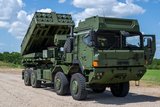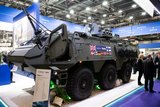MIT demonstrates portable hydrogen fuel generator for USMC
The prototype Hydrogen Tactical Refueling Point (H-TaRP). (Photo: USMC/Lance Cpl Cheyenne Stillion)
The Massachusetts Institute of Technology (MIT) Lincoln Laboratory has conducted a demonstration for the USMC of a prototype device to convert aluminium into hydrogen fuel.
If proven in further evaluations and broadly adopted, it could result in a ‘portable, readily available power source’ to replace heavy batteries that require recharging from a power source, the US Office of Naval Research (ONR) noted in a 15 February release.
This would align with the USMC vision for greater mobility and agility.
The device — called the Hydrogen Tactical Refueling Point (H-TaRP) — comprises an aluminium dispenser, reactor vessel, water cooling system and a control system manifold to fill a hydrogen tank.
It works by exploiting how aluminium reacts with water to generate hydrogen gas. ‘Any form of water works in the chemical reaction: salty ocean water, river water, even urine,’ the ONR noted.
Leftover steam from the fuel creation process could be distilled and used as drinking water.
‘H-TaRP’s purpose is to eliminate the need for diesel fuel transport and battery charging by being able to use locally available resources to produce hydrogen fuel for all sorts of vehicles,’ said Erik Limpacher, head of the Energy Systems Group at MIT Lincoln Laboratory.
Future plans for H-TaRP involve extended operation and high-pressure hydrogen generation. MIT also wants to halve the size of the device.
ONR is sponsoring the hydrogen fuel research effort under its Global TechSolutions programme. It chose MIT after a competitive process.
More from Land Warfare
-
![Croatia orders Leopards and CAESAR howitzers as Lithuania orders more CAESARs]()
Croatia orders Leopards and CAESAR howitzers as Lithuania orders more CAESARs
The Leopard is becoming the tank of choice in central and eastern Europe as Croatia joins Lithuania, the Czech Republic and Hungary in ordering the platform. Lithuania and Croatia have also signed for CAESAR howitzers.
-
![Light Reconnaissance Strike – enabling a vital mission set (Studio)]()
Light Reconnaissance Strike – enabling a vital mission set (Studio)
A new system-of-systems concept will unlock digital integration of sensors and weapons for Light Forces, allowing them to shape the battlefield environment on their own terms and upgrade legacy platforms.
-
![Lockheed Martin to look further afield for GMARS rocket system opportunities]()
Lockheed Martin to look further afield for GMARS rocket system opportunities
The HX truck is already in use in many NATO and allied countries around the world as a logistics vehicle and carrier for high-value systems, including missile firing weapons, so its use for the Global Mobile Artillery Rocket System makes logistical sense.
-
![Lithuanian 1st Division to achieve initial operating capability in 2026]()
Lithuanian 1st Division to achieve initial operating capability in 2026
Lithuania is one of the countries stepping up its defences in the face of the war in Ukraine with a particular focus on its neighbour and Russian ally Belarus, which has been making incursions into Lithuania’s airspace with balloons and drones.
-
Medium knocked out of British Army LMP, with CAVS as heavyweight champion
As the British Army seeks to modernise and consolidate its diverse vehicle fleet, yet another change in direction is underway.
-
![Energy evolution: How laser defence systems are powering the next phase of air defence (podcast)]()
Energy evolution: How laser defence systems are powering the next phase of air defence (podcast)
Laser-based air defence is moving from promise to deployment as global threats evolve. In this special podcast, we explore how high-energy laser systems are reshaping interception strategies.

























